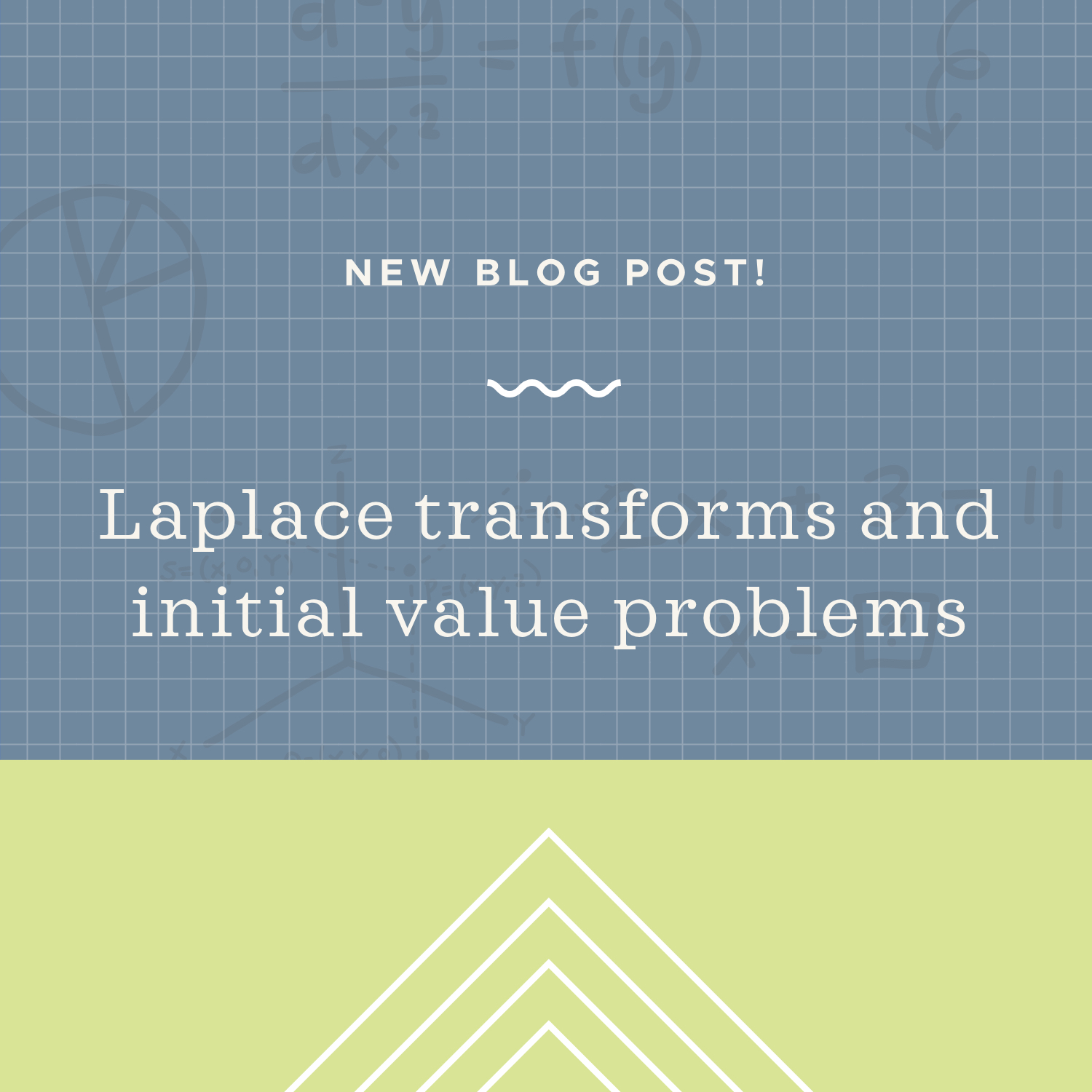Solving initial value problems using laplace transforms
How to solve initial value problems using Laplace transforms
To use a Laplace transform to solve a second-order nonhomogeneous differential equations initial value problem, we’ll need to use a table of Laplace transforms or the definition of the Laplace transform to put the differential equation in terms of ???Y(s)???.
Once we solve the resulting equation for ???Y(s)???, we’ll want to simplify it until we recognize that the terms in our equation match formulas in a table of Laplace transforms. Then we’ll make reverse substitutions for ???s??? in terms of ???t???.
Hi! I'm krista.
I create online courses to help you rock your math class. Read more.
Given a differential equation and initial conditions, use a table of Laplace transforms or the definition to solve the initial value problem
Take the course
Want to learn more about Differential Equations? I have a step-by-step course for that. :)
Step-by-step example for solving the initial value problem with a table of Laplace transforms
Example
Use a Laplace transform to solve the differential equation.
???y''-10y'+9y=5t???
with ???y(0)=-1??? and ???y'(0)=2???
To solve this problem using Laplace transforms, we will need to transform every term in our given differential equation. From a table of Laplace transforms, we can redefine each term in the differential equation.
???y''=s^2Y(s)-sy(0)-y'(0)???
???-10y'=-10\left[sY(s)-y(0)\right]???
???9y=9Y(s)???
???5t=\frac{5}{s^2}???
Plugging the transformed values back into the original equation gives
???s^2Y(s)-sy(0)-y'(0)-10\left[sY(s)-y(0)\right]+9Y(s)=\frac{5}{s^2}???
Now we’ll plug in the given initial conditions ???y(0)=-1??? and ???y'(0)=2???.
???s^2Y(s)-s(-1)-(2)-10\left[sY(s)-(-1)\right]+9Y(s)=\frac{5}{s^2}???
???s^2Y(s)+s-2-10\left[sY(s)+1\right]+9Y(s)=\frac{5}{s^2}???
???s^2Y(s)+s-2-10sY(s)-10+9Y(s)=\frac{5}{s^2}???
???s^2Y(s)+s-10sY(s)+9Y(s)-12=\frac{5}{s^2}???
From here we want to solve for ???Y(s)??? so that we can use a reverse Laplace transform to change this equation into an equation for ???y(t)???.
???s^2Y(s)-10sY(s)+9Y(s)=\frac{5}{s^2}+12-s???
???s^2Y(s)-10sY(s)+9Y(s)=\frac{5+12s^2-s^3}{s^2}???
???Y(s)\left(s^2-10s+9\right)=\frac{5+12s^2-s^3}{s^2}???
???Y(s)(s-9)(s-1)=\frac{5+12s^2-s^3}{s^2}???
???Y(s)(s-9)(s-1)=\frac{5+12s^2-s^3}{s^2}???
???Y(s)=\frac{5+12s^2-s^3}{s^2(s-9)(s-1)}???
Once we solve the resulting equation for Y(s), we’ll want to simplify it until we recognize that the terms in our equation match formulas in a table of Laplace transforms.
We’ll need to use a partial fractions decomposition.
???\frac{5+12s^2-s^3}{s^2(s-9)(s-1)}=\frac{A}{s}+\frac{B}{s^2}+\frac{C}{s-9}+\frac{D}{s-1}???
???5+12s^2-s^3=As(s-9)(s-1)+B(s-9)(s-1)???
???+Cs^2(s-1)+Ds^2(s-9)???
???5+12s^2-s^3=As\left(s^2-10s+9\right)+B\left(s^2-10s+9\right)???
???+C\left(s^3-s^2\right)+D\left(s^3-9s^2\right)???
???5+12s^2-s^3=As^3-10As^2+9As+Bs^2-10Bs+9B???
???+Cs^3-Cs^2+Ds^3-9Ds^2???
???5+12s^2-s^3=\left(As^3+Cs^3+Ds^3\right)+\left(-10As^2+Bs^2-Cs^2-9Ds^2\right)???
???+\left(9As-10Bs\right)+9B???
???5+12s^2-s^3=\left(A+C+D\right)s^3+\left(-10A+B-C-9D\right)s^2???
???+\left(9A-10B\right)s+9B???
Equating coefficients, we get a system of linear equations.
???A+C+D=-1???
???-10A+B-C-9D=12???
???9A-10B=0???
???9B=5???
Solving the fourth equation for ???B??? gives
???B=\frac59???
Plugging this into the third equation gives
???9A-10\left(\frac59\right)=0???
???9A-\frac{50}{9}=0???
???81A-50=0???
???81A=50???
???A=\frac{50}{81}???
Plugging the values we’ve found for ???A??? and ???B??? into the first two equation gives
???\frac{50}{81}+C+D=-1???
???-10\left(\frac{50}{81}\right)+\frac59-C-9D=12???
which is
???C+D=-1-\frac{50}{81}???
???-\frac{500}{81}+\frac59-C-9D=12???
which is
???C+D=-\frac{81}{81}-\frac{50}{81}???
???-C-9D=12+\frac{500}{81}-\frac59???
which is
???C+D=-\frac{131}{81}???
???-C-9D=\frac{972}{81}+\frac{500}{81}-\frac{45}{81}???
which is
[1] ???C+D=-\frac{131}{81}???
[2] ???-C-9D=\frac{1,427}{81}???
Adding [1] and [2] together gives
???C+D+(-C-9D)=-\frac{131}{81}+\frac{1,427}{81}???
???C+D-C-9D=\frac{1,296}{81}???
???D-9D=16???
???-8D=16???
[3] ???D=-2???
Plugging [3] into [1] we get
???C+D=-\frac{131}{81}???
???C-2=-\frac{131}{81}???
???C=-\frac{131}{81}+\frac{162}{81}???
???C=\frac{31}{81}???
Plugging the values we found for ???A???, ???B???, ???C??? and ???D??? back into the partial fractions decomposition will give us
???Y(s)=\frac{\frac{50}{81}}{s}+\frac{\frac{5}{9}}{s^2}+\frac{\frac{31}{81}}{s-9}-\frac{2}{s-1}???
We’ll rearrange each term in the decomposition to make it easier to find a matching formula in the Laplace transform table.
???Y(s)=\frac{50}{81}\left(\frac{1}{s}\right)+\frac{5}{9}\left(\frac{1}{s^2}\right)+\frac{31}{81}\left(\frac{1}{s-9}\right)-2\left(\frac{1}{s-1}\right)???
The terms remaining inside the parentheses should remind us of these transformations:
???1=\frac{1}{s}???
???t=\frac{1}{s^2}???
???e^{9t}=\frac{1}{s-9}???
???e^{t}=\frac{1}{s-1}???
We’ll make these substitutions to get an equation for ???y(t)???.
???y(t)=\frac{50}{81}+\frac{5}{9}t+\frac{31}{81}e^{9t}-2e^t???
This is the solution to the initial value problem.






